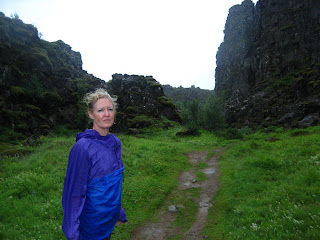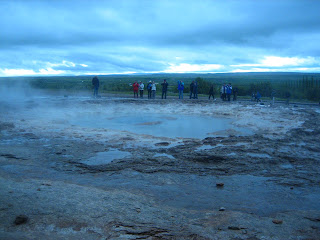Pingvellir
Be that as it may, Pingvellir is characterized as the most important historical site in Iceland. Geologically, too, it's noteworthy. First, the history. In 930, this was the site of the world's first democratic parliament, established by the Vikings. The Alping met annually, with participants reciting the Law, using the rocks as a natural boom box to project their voices and, one supposes, doing the Viking equivalent of revising and extending the debate.
Viking 1: Will the gentleman yield?
Viking 2: No, I will not yield.
Viking 1: Then taste the hot steel of my avenging broadaxe!!
Viking 2: ArgggHHH!!!
Speaker of the Parliament: The gentleman's time has expired.
Geysir
Driving around the eastern edge of the lake at Pingviller, we strike east on a decent, two-lane road that traverses rolling hills with mountains in the not-so-distant viewshed. Geysir is the site that gave its name to the whole geyser clan, although the Big Daddy site is now relatively quiet. The neighboring geyser known as Strokkur, though, reliably pops its top every six minutes or so.
A single strand of cable keeps the spectators at a distance, perhaps 100 feet. The eruption is preceded by a whorl and swirl of water inside the cauldron, and then the plume bursts skyward, perhaps 15 feet in height.
For what passes as one of Iceland's biggest tourist attractions, there is a marked and delightful lack of hype about the place. There are no big signs promoting the site on the road in; you just, suddenly, are there. A visitor center on the other side of the street has a large gift shop and a decent cafe.
Gullfoss
The wonderful waterfall(s) at Gullfoss are only 10 kilometers east of Geysir, but there's a bit of an invigorating walk from the parking area/visitor center to the fall overlook.
These double falls easily live up to their billing. The walk to the main overlook can be crowded, and the overlooks themselves a bit treacherous; they are wet, craggy and with only a shin-high cable to keep people from falling to their doom. One notes the bracking lack of nagging signs and nanny-state protective devices; here, one feels, risk is taken as it comes.










